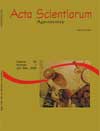Growth, parthenolide and proline contents in <em>Tanacetum parthenium</em> (L. ) Schultz Bip
Abstract
In substratum of different humidity contents. Aiming at determining the effect of soil's water levels on the parthenolide contents of plants aerial parts, this experiment used feverfew [Tanacetum parthenium (L. ) Schultz Bip. ], grown in 5-L vases, with substratum kept at 100%, 90%, 70% and 50% field capacity. In the substratum highest water availability levels, plants showed larger height, more leaves, higher total leaf area and higher parthenolide content. In the lowest water availability level, the following decreases were verified: 16% in plants height, 13% in number of leaves, 14% in leaf area and 28% in parthenolide content, and an increase in the proline content. This suggests that higher water levels in soil are more appropriate for producing plants with larger parthenolide content.Downloads
Download data is not yet available.
Published
2008-04-11
How to Cite
Carvalho, L. M. de, Casali, V. W. D., Souza, M. A. de, Barbosa, L. C. de A., & Cecon, P. R. (2008). Growth, parthenolide and proline contents in <em>Tanacetum parthenium</em> (L. ) Schultz Bip. Acta Scientiarum. Agronomy, 27(1), 151-157. https://doi.org/10.4025/actasciagron.v27i1.2137
Issue
Section
Crop Production
DECLARATION OF ORIGINALITY AND COPYRIGHTS
I Declare that current article is original and has not been submitted for publication, in part or in whole, to any other national or international journal.
The copyrights belong exclusively to the authors. Published content is licensed under Creative Commons Attribution 4.0 (CC BY 4.0) guidelines, which allows sharing (copy and distribution of the material in any medium or format) and adaptation (remix, transform, and build upon the material) for any purpose, even commercially, under the terms of attribution.
2.0
2019CiteScore
60th percentile
Powered by 

2.0
2019CiteScore
60th percentile
Powered by 



















































